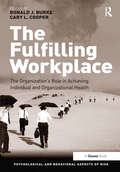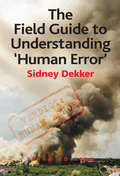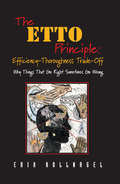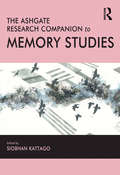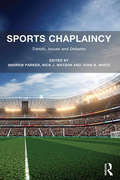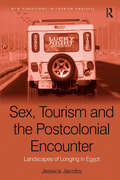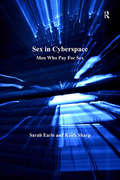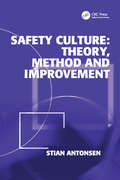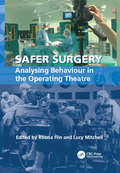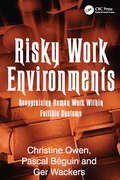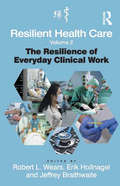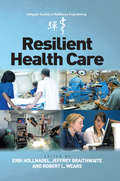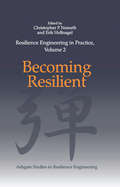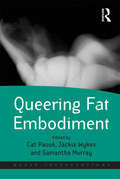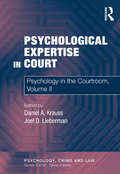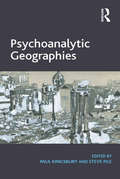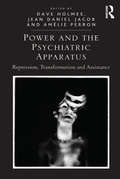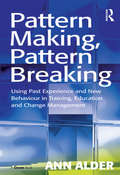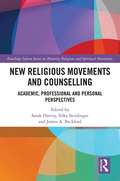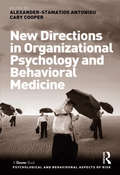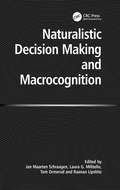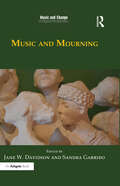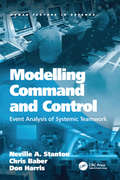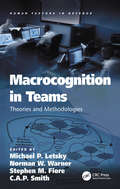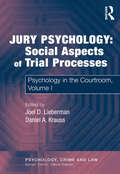- Table View
- List View
The Fulfilling Workplace: The Organization's Role in Achieving Individual and Organizational Health (Psychological and Behavioural Aspects of Risk)
by Ronald J. BurkeIt is very easy for organizations to ignore or overlook the impact of social and commercial change-of increased pressure to deliver profit (above all else) and of transformation in the ways in which we are now working-on the mental health and, consequently, the performance of their employees. And yet there is plenty of evidence that in many workplaces, performance is down, stress is up and professional employees are struggling to balance their home and work lives. This collection, while looking at individuals, places the spotlight on organizational initiatives to support the development of attitudes, values, character and behaviors in employees. The aim of these initiatives is to increase our resilience to those experiences and events which impact on performance. There is a particular focus on managerial and professional jobs where employee discretion and commitment are critical. The Fulfilling Workplace extends the themes developed in early titles in the Psychological and Behavioral Aspects of Risk Series deeper into organizations; to explore the organization's role in coming to grips both with human frailties and toxic workplaces-both destructive to individual and organizational health.
The Field Guide to Understanding 'Human Error': Second Edtion
by Sidney DekkerWhen faced with a ’human error’ problem, you may be tempted to ask 'Why didn’t these people watch out better?' Or, 'How can I get my people more engaged in safety?' You might think you can solve your safety problems by telling your people to be more careful, by reprimanding the miscreants, by issuing a new rule or procedure and demanding compliance. These are all expressions of 'The Bad Apple Theory' where you believe your system is basically safe if it were not for those few unreliable people in it. Building on its successful predecessors, the third edition of The Field Guide to Understanding ’Human Error’ will help you understand a new way of dealing with a perceived 'human error' problem in your organization. It will help you trace how your organization juggles inherent trade-offs between safety and other pressures and expectations, suggesting that you are not the custodian of an already safe system. It will encourage you to start looking more closely at the performance that others may still call 'human error', allowing you to discover how your people create safety through practice, at all levels of your organization, mostly successfully, under the pressure of resource constraints and multiple conflicting goals. The Field Guide to Understanding 'Human Error' will help you understand how to move beyond 'human error'; how to understand accidents; how to do better investigations; how to understand and improve your safety work. You will be invited to think creatively and differently about the safety issues you and your organization face. In each, you will find possibilities for a new language, for different concepts, and for new leverage points to influence your own thinking and practice, as well as that of your colleagues and organization. If you are faced with a ’human error’ problem, abandon the fallacy of a quick fix. Read this book.
The ETTO Principle: Why Things That Go Right Sometimes Go Wrong
by Erik HollnagelAccident investigation and risk assessment have for decades focused on the human factor, particularly 'human error'. Countless books and papers have been written about how to identify, classify, eliminate, prevent and compensate for it. This bias towards the study of performance failures, leads to a neglect of normal or 'error-free' performance and the assumption that as failures and successes have different origins there is little to be gained from studying them together. Erik Hollnagel believes this assumption is false and that safety cannot be attained only by eliminating risks and failures. The ETTO Principle looks at the common trait of people at work to adjust what they do to match the conditions - to what has happened, to what happens, and to what may happen. It proposes that this efficiency-thoroughness trade-off (ETTO) - usually sacrificing thoroughness for efficiency - is normal. While in some cases the adjustments may lead to adverse outcomes, these are due to the very same processes that produce successes, rather than to errors and malfunctions. The ETTO Principle removes the need for specialised theories and models of failure and 'human error' and offers a viable basis for effective and just approaches to both reactive and proactive safety management.
The Ashgate Research Companion to Memory Studies
by Siobhan KattagoMemory has long been a subject of fascination for poets, artists, philosophers and historians. This timely volume, edited by Siobhan Kattago, examines how past events are remembered, contested, forgotten, learned from and shared with others. Each author in The Ashgate Research Companion to Memory Studies has been asked to reflect on his or her research companions as a scholar, who studies memory. The original studies presented in the volume are written by leading experts, who emphasize both the continuity of heritage and tradition, as well as the memory of hostilities, traumas and painful events. Comprised of four thematic sections, The Ashgate Research Companion to Memory Studies provides a comprehensive overview of the latest research within the discipline. The principal themes include: ¢ Memory, History and Time ¢ Social, Psychological and Cultural Frameworks of Memory ¢ Acts and Places of Memory ¢ Politics of Memory, Forgetting and Democracy Featuring contributions from key thinkers in the field, this comprehensive volume will be a valuable resource for all academics and students working within this area of study.
Sports Chaplaincy: Trends, Issues and Debates
by Andrew Parker John B. White Nick J. WatsonThis ground-breaking book provides an in-depth analysis of the theory and practice of sports chaplaincy in a global context. Written in an accessible style, yet based on academic evidence and theory, the contributors include those leading major national chaplaincy organisations located in the UK, US, Australia and Continental Europe, as well as chaplains and sport psychologists working in elite and amateur sport and those involved in teaching pastoral theology. Providing a rich and informative source of knowledge and inspiration for practitioners, athletes, academics and those interested in the general relationship between sport and faith, contributors also address the provision of sports chaplaincy at sporting mega-events, including the Olympic Games. This much needed overview of chaplaincy provision in sport across a range of national and international contexts and settings, including both catholic and protestant perspectives, is the first collection of its kind to bring together leading scholars in sports chaplaincy with a view to providing professional accreditation and training amidst the fast-emerging field of sports theology.
Sex, Tourism and the Postcolonial Encounter: Landscapes of Longing in Egypt (New Directions in Tourism Analysis)
by Jessica JacobsIllustrated by revealing interviews with women and men in the tourist resorts in the Sinai, Egypt, this book is ostensibly about western women who sleep with 'native' men while on holiday. Broadening the scope of issues involved, it examines the link between these holiday romances and a much wider romanticism of place and people - of the landscapes of paradise, deserts and the lure of the Bedouin sheikh - that are used to sell these destinations. It argues that the romantic stereotyping and deliberate positioning of 'Third World' resorts as places that somehow exist outside of the modernities the women come from is inextricably bound up in the relationships. Similarly, for the local man the tourist resort is perceived as a place other than his own cultural space and time and represents a modernity that is otherwise only found in the 'West'. The relationships that ensue can therefore only occur because the tourist resort acts as an intermediate space. In analyzing the interaction of these men and women within the context of modernity, the book provides insights into gender issues to do with globalization, travel and sexuality, as well as opening up the debate on sex tourism and showing this to be a lot more ambiguous and complicated than it might at first appear.
Sex in Cyberspace: Men Who Pay For Sex
by Sarah Earle Keith SharpSex in Cyberspace offers a bold and provocative, yet sensitively written, account of an under-investigated area of sociological enquiry. While there is a considerable amount of research documenting the experiences of sex workers, very little data exists on their male clientele. The first empirically-based volume on the experiences of men who pay for sex, this work presents a significant new source of data. The book is based upon an extensive study of on-line forums in which both the purchasers of sexual services and the workers themselves can exchange information and views - information which is otherwise extremely difficult to obtain. Sarah Earle and Keith Sharp argue that such sites represent a significant change in the social organization of sex work and those who seek and use the services of sex workers. Shedding new light on men's sexual identity, Sex in Cyberspace makes a major contribution to the study of sexuality.
Safety Culture: Theory Method And Improvement
by Stian AntonsenThe aim of this book is to show how a cultural approach can contribute to the assessment, description and improvement of safety conditions in organizations. The relationship between organizational culture and safety, epitomized through the concept of 'safety culture', has undoubtedly become one of the hottest topics of both safety research and practical efforts to improve safety. By combining a general framework and five research projects, the author explores and further develops the theoretical, methodological and practical basis of the study of safety culture. What are the theoretical foundations of a cultural approach to safety? How can the relationship between organizational culture and safety be empirically investigated? What are the links between organizational culture and safety in actual organizations? How can a cultural approach contribute to the improvement of safety? These are the key questions the book seeks to answer with a unified and in-depth account of the concept of safety culture.
Safer Surgery: Analysing Behaviour in the Operating Theatre
by Lucy Mitchell Rhona FlinOperating theatres are very private workplaces. There have been few research investigations into how highly trained doctors and nurses work together to achieve safe and efficient anaesthesia and surgery. While there have been major advances in surgical and anaesthetic procedures, there are still significant risks for patients during operations and adverse events are not unknown. Due to rising concern about patient safety, surgeons and anaesthetists have looked for ways of minimising adverse events. Behavioural scientists have been encouraged by clinicians to bring research techniques used in other industries into the operating theatre in order to study the behaviour of surgeons, nurses and anaesthetists. Safer Surgery presents one of the first collections of studies designed to understand the factors influencing safe and efficient surgical, anaesthetic and nursing practice. The book is written by psychologists, surgeons and anaesthetists, whose contributions combine to offer readers the latest research techniques and findings from some of the leading investigators in this field. It is designed for practitioners and researchers interested in understanding the behaviour of operating theatre team members, with a view to enhancing both training and practice. The material is also suitable for those studying behaviour in other areas of healthcare or in high-risk work settings. The aims of the book are to: a) present the latest research on the behaviour of operating theatre teams b) describe the techniques being used by psychologists and clinicians to study surgeons, anaesthetists and theatre nurses' task performance c) outline the safety implications of the research to date.
Risky Work Environments: Reappraising Human Work Within Fallible Systems
by Pascal BéguinRisky Work Environments provides new insights into the multiple and dynamic trajectories of both near misses and mistakes in complex work environments, based on actual case examples. It also studies the interactions between various activity systems or work practices (design, maintenance, incident investigation, regulation, operation) and their consequences for operational performance. The role of rules and regulations is explored, considering the consequences of deviations and the limitations of enforced compliance. Further, the book explains how to search for, think about and act on information about vulnerability, near misses and mistakes in a way that emphasizes accountability in ways that are not punitive but instead responsible, innovative and provide opportunities for learning. Writing from different disciplines and theoretical perspectives, the contributors analyse working in risky environments which include air traffic control, offshore mining, chemical plants, neo-natal intensive care units, ship piloting and emergency call dispatch centres. In each chapter the authors present rich empirical data and their analyses illustrate a variety of ways in which, despite imperfect systems, safety and resilience is created in human action. In the chapters where the focus is on error or mistakes, the analysis undertaken reveals the logic of actions undertaken at the time as well as their constraints. The contributors are all active researchers within their disciplines and come from Australia, Finland, France, Norway and the Netherlands. The book will be of direct interest to safety scientists, researchers and scientists, as well as human factors practitioners working in complex technological systems.
Resilient Health Care, Volume 2: The Resilience of Everyday Clinical Work (Ashgate Studies in Resilience Engineering)
by Robert L. Wears Erik HollnagelHealth systems everywhere are expected to meet increasing public and political demands for accessible, high-quality care. Policy-makers, managers, and clinicians use their best efforts to improve efficiency, safety, quality, and economic viability. One solution has been to mimic approaches that have been shown to work in other domains, such as quality management, lean production, and high reliability. In the enthusiasm for such solutions, scant attention has been paid to the fact that health care as a multifaceted system differs significantly from most traditional industries. Solutions based on linear thinking in engineered systems do not work well in complicated, multi-stakeholder non-engineered systems, of which health care is a leading example. A prerequisite for improving health care and making it more resilient is that the nature of everyday clinical work be well understood. Yet the focus of the majority of policy or management solutions, as well as that of accreditation and regulation, is work as it ought to be (also known as ’work-as-imagined’). The aim of policy-makers and managers, whether the priority is safety, quality, or efficiency, is therefore to make everyday clinical work - or work-as-done - comply with work-as-imagined. This fails to recognise that this normative conception of work is often oversimplified, incomplete, and outdated. There is therefore an urgent need to better understand everyday clinical work as it is done. Despite the common focus on deviations and failures, it is undeniable that clinical work goes right far more often than it goes wrong, and that we only can make it better if we understand how this happens. This second volume of Resilient Health Care continues the line of thinking of the first book, but takes it further through a range of chapters from leading international thinkers on resilience and health care. Where the first book provided the rationale and basic concepts of RHC, the Resilience of Everyday Clinical Work b
Resilient Health Care: The Resilience Of Everyday Clinical Work (Ashgate Studies in Resilience Engineering)
by Jeffrey Braithwaite Erik HollnagelHealth care is everywhere under tremendous pressure with regard to efficiency, safety, and economic viability - to say nothing of having to meet various political agendas - and has responded by eagerly adopting techniques that have been useful in other industries, such as quality management, lean production, and high reliability. This has on the whole been met with limited success because health care as a non-trivial and multifaceted system differs significantly from most traditional industries. In order to allow health care systems to perform as expected and required, it is necessary to have concepts and methods that are able to cope with this complexity. Resilience engineering provides that capacity because its focus is on a system’s overall ability to sustain required operations under both expected and unexpected conditions rather than on individual features or qualities. Resilience engineering’s unique approach emphasises the usefulness of performance variability, and that successes and failures have the same aetiology. This book contains contributions from acknowledged international experts in health care, organisational studies and patient safety, as well as resilience engineering. Whereas current safety approaches primarily aim to reduce or eliminate the number of things that go wrong, Resilient Health Care aims to increase and improve the number of things that go right. Just as the WHO argues that health is more than the absence of illness, so does Resilient Health Care argue that safety is more than the absence of risk and accidents. This can be achieved by making use of the concrete experiences of resilience engineering, both conceptually (ways of thinking) and practically (ways of acting).
Resilience Engineering in Practice, Volume 2: Becoming Resilient (Ashgate Studies in Resilience Engineering)
by Erik Hollnagel Christopher P. NemethThis is the fifth book published within the Ashgate Studies in Resilience Engineering series. The first volume introduced resilience engineering broadly. The second and third volumes established the research foundation for the real-world applications that then were described in the fourth volume: Resilience Engineering in Practice. The current volume continues this development by focusing on the role of resilience in the development of solutions. Since its inception, the development of resilience engineering as a concept and a field of practice has insisted on expanding the scope from a preoccupation with failure to include also the acceptable everyday functioning of a system or an organisation. The preoccupation with failures and adverse outcomes focuses on situations where something goes wrong and the tries to keep the number of such events and their (adverse) outcomes as low as possible. The aim of resilience engineering and of this volume is to describe how safety can change from being protective to become productive and increase the number of things that go right by improving the resilience of the system.
Queering Fat Embodiment (Queer Interventions)
by Samantha Murray Cat Pausé Jackie WykesCultural anxieties about fatness and the attendant stigmatisation of fat bodies, have lent a medical authority and cultural legitimacy to what can be described as ’fat-phobia’. Against the backdrop of the ever-growing medicalisation, pathologisation, and commodification of fatness, coupled with the moral panic over an alleged ’obesity epidemic’, this volume brings together the latest scholarship from various critical disciplines to challenge existing ideas of fat and fat embodiment. Shedding light on the ways in which fat embodiment is lived, experienced, regulated and (re)produced across a range of cultural sites and contexts, Queering Fat Embodiment destabilises established ideas about fat bodies, making explicit the intersectionality of fat identities and thereby countering the assertion that fat studies has in recent years reproduced a white, ableist, heteronormative subjectivity in its analyses. A critical queer examination on fatness, Queering Fat Embodiment will be of interest to scholars of cultural and queer theory, sociology and media studies, working on questions of embodiment, stigmatisation and gender and sexuality.
Psychological Expertise in Court: Psychology in the Courtroom, Volume II (Psychology, Crime, And Law Ser.)
by Daniel A. KraussExpertise in Court: Perspectives on Testimony is the second of a two-volume set on the Psychology of the Courtroom. The authors, a renowned group of psychology and legal scholars, offer definitive coverage of the use of psychological expert testimony and evidence in a variety of legal contexts. They explore the controversies that surround it, from questions of its admissibility to its effects on eventual juror decisions. A wide range of topics are covered including system and estimator variables in eyewitness identification, expert testimony on psychological syndromes, the insanity defence and sexual harassment, how child sexual abuse is used by the courts, and recent research on false confessions. They also provide a comparative analysis exploring how different types of psychological expert testimony and evidence are used by different countries’ legal systems. All the chapters conclude by making specific recommendations for how psychological research and information could be better utilized by courts around the world.
Psychoanalytic Geographies
by Steve Pile Paul KingsburyPsychoanalytic Geographies is a unique, path-breaking volume and a core text for anyone seeking to grasp how psychoanalysis helps us understand fundamental geographical questions, and how geographical understandings can offer new ways of thinking psychoanalytically. Elaborating on a variety of psychoanalytic approaches that embrace geographical imaginations and a commitment toward spatial thinking, this book demonstrates the breadth, depth, and vitality of cutting edge work in psychoanalytic geographies and presents readers with as wide a set of options as possible for taking psychoanalysis forward in their own work. It covers a wide range of themes and perspectives in terms of theoretical approaches such as Freudian, Lacanian, Kristevan, and Irigarayian; conceptual issues such as space, power, identity, culture, political economy, colonialism, ethics, and aesthetics; disciplinary insights including Geography, English, Sexuality Studies, and History of Science; as well as empirical contexts such as the reception of psychoanalysis in early twentieth century England, psychoanalytic geographies of violence and creativity in a small Mexican city, visual cultures of second-generation Iranian artists living in Los Angeles, and the hysterical underpinnings of climate change scepticism.
Power and the Psychiatric Apparatus: Repression, Transformation and Assistance
by Dave Holmes Jean Daniel JacobDrawing on a broad range of approaches in the fields of sociology, anthropology, political science, history, philosophy, medicine and nursing, Power and the Psychiatric Apparatus exposes psychiatric practices that are mobilized along the continuum of repression, transformation and assistance. It critically examines taken for granted psychiatric practices both past and current, shedding light on the often political nature of psychiatry and reconceptualizing its central and sensitive issues through the radical theory of figures such as Foucault, Deleuze and Guattari, Goffman, and Szasz. As such, this ground-breaking collection embraces a broad understanding of psychiatric practices and engages the reader in a critical understanding of their effects, challenging the discipline’s altruistic rhetoric of therapy and problematizing the ways in which this is operationalized in practice. A comprehensive exploration of contested psychiatric practices in healthcare settings, this interdisciplinary volume brings together recent scholarship from the US, Canada, the UK, Europe and Australia, to provide a rich array of theoretical tools with which to engage with questions related to psychiatric power, discipline and control, while theorizing their workings in creative and imaginative ways.
Pattern Making, Pattern Breaking: Using Past Experience and New Behaviour in Training, Education and Change Management
by Ann AlderRapid changes in technology, the nature of organisations, non-traditional career progression, globalisation and ’virtual worlds’ mean that we need to become ever more effective learners in order to keep pace with the demands placed upon us. Our patterns of understanding, the ways in which we make sense of our work and our world, hardly become fixed before we are asked to change them and form new ones. The ability to build patterns is fundamental to our ability to learn. Ann Alder’s Pattern Making, Pattern Breaking explores the ways in which educators and facilitators can work to help students build those patterns that will be most useful to them. These may be ’technical’ patterns of language, number, sequence or process. They may be thinking patterns that support problem-solving, creativity, logical analysis or empathy. They may be patterns of behaviour that demonstrate trust, influence or integrity in relationships. Ann also illustrates how you can teach students to break patterns: to help them move on in the learning process by recognising and rejecting long-held patterns of behaviour or assumptions that are unhelpful or redundant. Formal education and training do not necessarily produce learners who are well-resourced to take advantage of opportunities that arise and to avoid some of the stresses that uncertainty, ambiguity or imposed change place upon them. So, perhaps one of the most important patterns that we can explore and understand as we move forward, in a changing world, is our own pattern of learning. Whether you are a parent, teacher, tutor, trainer, coach or manager, you need to be an effective facilitator of learning and this book is the perfect starting place.
New Religious Movements and Counselling: Academic, Professional and Personal Perspectives (Routledge Inform Series on Minority Religions and Spiritual Movements)
by James A. Beckford Sarah Harvey Silke SteidingerThere are many different ways in which minority religions and counselling may interact. In some cases there can be antagonism between counselling services and minority religions, with each suspecting they are ideologically threatened by the other, but it can be argued that the most common relationship is one of ignorance – mental health professionals do not pay much attention to religion and often do not ask or consider their client’s religious affiliation. To date, the understanding of this relationship has focused on the ‘anti-cult movement’ and the perceived need for members of minority religions to undergo some form of ‘exit counselling’. In line with the series, this volume takes a non-judgemental approach and instead highlights the variety of issues, religious groups and counselling approaches that are relevant at the interface between minority religion and counselling. The volume is divided into four parts: Part I offers perspectives on counselling from different professions; Part II offers chapters from the field leaders directly involved in counselling former members of minority religions; Part III offers unique personal accounts by members and former members of a number of different new religions; while Part IV offers chapters on some of the most pertinent current issues in the counselling/minority religions fields, written by new and established academics. In every section, the volume seeks to explore different permutations of the counsellor-client relationship when religious identities are taken into account. This includes not only ‘secular’ therapists counselling former members of religion, but the complexities of the former member turned counsellor, as well as counselling practised both within religious movements and by religious movements that offer counselling services to the ‘outside’ world.
New Directions in Organizational Psychology and Behavioral Medicine (Psychological and Behavioural Aspects of Risk)
by Cary CooperThis research shows the dynamic relationship between work, health and satisfaction. New Directions in Organizational Psychology and Behavioral Medicine, comprehensively covers new developments in the field of occupational health psychology and provides insight into the many challenges that will change the nature of occupational health psychology. The editors have gathered 40 experts from all over the developed world to discuss issues relevant to human resource and talent management, and specifically to employment related physical and psychological health issues. Especially because it comes at a time of economic turbulence that will create work stress and strain, organizations, researchers and practitioners will find this book valuable.
Naturalistic Decision Making and Macrocognition
by Jan Maarten SchraagenThis book presents the latest work in the area of naturalistic decision making (NDM) and its extension into the area of macrocognition. It contains 18 chapters relating research centered on the study of expertise in naturalistic settings, written by international experts in NDM and cognitive systems engineering. The objective of the book is to present the reader with exciting new developments in this field of research, which is characterized by its application-oriented focus. The work addresses only real-world problems and issues. For instance, how do multi-national teams collaborate effectively? How can surgeons best be supported by technology? How do detectives make sense of complex criminal cases? In all instances the studies have been carried out on experts within their respective domains. The traditional field of NDM is extended in this work by focusing on macrocognitive functions other than decision making, namely sense-making, coordination and planning. This has broadened the scope of the field. The book also contains a theoretical discussion of the macro-micro distinction. Naturalistic Decision Making and Macrocognition will be relevant to graduate students, researchers and professionals (including professionals and researchers in business, industry and government) who are interested in decision making, expertise, training methods and system design. The material may be used in two ways: theoretically, to advance understanding of the field of naturalistic decision making; and practically, to gain insight into how experts in various domains solve particular problems, understand and deal with issues and collaborate with others.
Music and Mourning (Music and Change: Ecological Perspectives)
by Sandra Garrido Jane W. DavidsonWhile grief is suffered in all cultures, it is expressed differently all over the world in accordance with local customs and beliefs. Music has been associated with the healing of grief for many centuries, with Homer prescribing music as an antidote to sorrow as early as the 7th Century BC. The changing role of music in expressions of grief and mourning throughout history and in different cultures reflects the changing attitudes of society towards life and death itself. This volume investigates the role of music in mourning rituals across time and culture, discussing the subject from the multiple perspectives of music history, music psychology, ethnomusicology and music therapy.
Modelling Command and Control: Event Analysis of Systemic Teamwork (Human Factors in Defence)
by Neville A. Stanton Chris BaberSince its inception, just after the Second World War, Human Factors research has paid special attention to the issues surrounding human control of systems. Command and control environments continue to represent a challenging domain for human factors research. Modelling Command and Control takes a broad view of command and control research, to include C2 (command and control), C3 (command, control and communication), and C4 (command, control, communication and computers) as well as human supervisory control paradigms. The book presents case studies in diverse military applications (for example, land, sea and air) of command and control. The book explores the differences and similarities in the land, sea and air domains; the theoretical and methodological developments, approaches to system and interface design, and the workload and situation awareness issues involved. It places the role of humans as central and distinct from other aspects of the system. Using extensive case study material, Modelling Command and Control demonstrates how the social and technical domains interact, and why each require equal treatment and importance in the future.
Macrocognition in Teams: Theories and Methodologies (Human Factors in Defence)
by Stephen M. Fiore Michael P. Letsky C.A.P. Smith Norman W. WarnerTeam collaboration involves many operational tasks such as team decision-making or course of action selection, developing shared understanding, and intelligence analysis. These operational tasks must be performed in many situations, often under severe time pressure, with information and knowledge uncertainty, large amounts of dynamic information and across different team characteristics. Recent research in this area has focused on various aspects of human collaborative decision-making and the underlying cognitive processes while describing those processes at different levels of detail, making it difficult to compare research results. The theoretical construct of ’macrocognition in teams’ was developed to facilitate cognitive research in team collaboration, which will enable a common level of understanding when defining, measuring and discussing the cognitive processes in team collaboration. Macrocognition is defined as both the internalized and externalized mental processes employed by team members in complex, one-of-a-kind, collaborative problem solving. Macrocognition in Teams provides readers with a greater understanding of the macrocognitive processes which support collaborative team activity, showcasing current research, theories, methodologies and tools. It will be of direct relevance to academics, researchers and practitioners interested in group/team interaction, performance, development and training.
Jury Psychology: Psychology in the Courtroom, Volume I (Psychology, Crime And Law Ser.)
by Daniel A. KraussThe first of a two-volume set on the Psychology of the Courtroom, Jury Psychology: Social Aspects of Trial Processes offers a definitive account of the influence of trial procedures on juror decision-making. A wide range of topics are covered including pre-trial publicity and inadmissible evidence, jury selection, jury instruction, and death penalty cases, as well as decision-making in civil trials. In addition, a number of global issues are discussed, including procedural justice issues and theoretical models of juror decision-making. Throughout the volume the authors make recommendations for improving trial procedures where jurors are involved, and they discuss how the problems and potential solutions are relevant to courts around the world.
